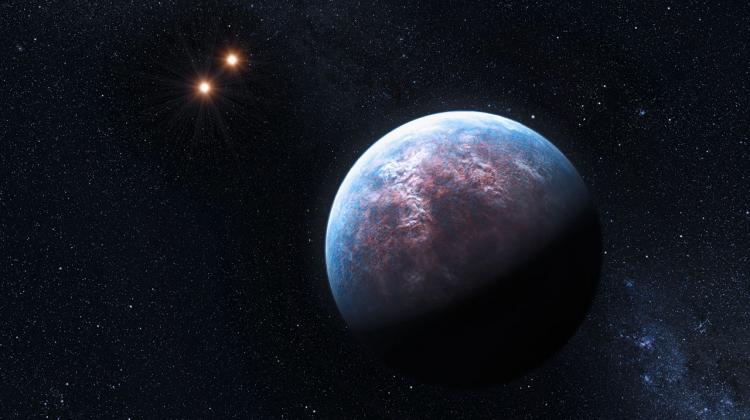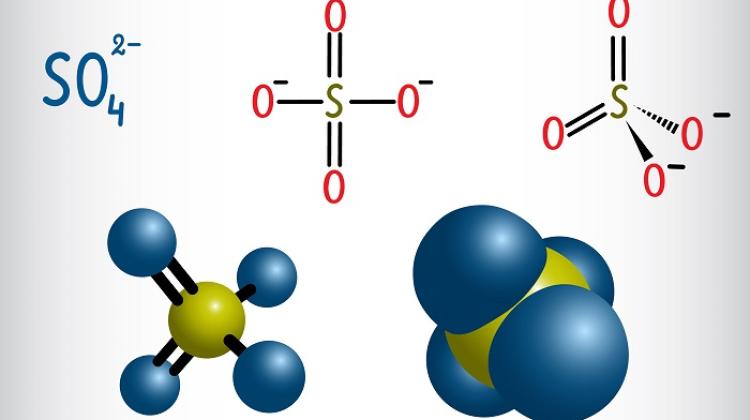Polish astronomers discover a planet similar to Uranus
 Artistic impression of an extrasolar planet in a binary star system. Source: Źródło: ESO/L. Calçada.
Artistic impression of an extrasolar planet in a binary star system. Source: Źródło: ESO/L. Calçada.
A team composed mainly of astronomers from the University of Warsaw and headed by Polish astronomer working in the United States, discovered extrasolar planet somewhat similar to Uranus, distant by 25 thousand light years.
The discovery has been reported in the latest online edition of "The Astrophysical Journal".
Astronomers already know hundreds of extrasolar planets. Most of them are gas giants such as Jupiter in our solar system, or smaller rocky globes, such as the Earth. But there may also be planet composed partly of gas and partly of ice; examples in our solar system are Uranus and Neptune.
An international team of astronomers has discovered a distant planet similar to Uranus. Team leader was Radosław Poleski, Polish astronomer working at the Ohio State University, Columbus (U.S.). The authors list contains a total of 14 names, including 11 Polish astronomers from the University of Warsaw Astronomical Observatory. One of them is Prof. Andrzej Udalski.
The astronomers discover the planet due to the phenomenon of gravitational microlensing. When a different object is present between us and a distant star (for example another star), its gravitational field may disrupt the light beam, causing the brightening of a distant star. Sometimes, actually very rarely, when the gravitational microlensing phenomenon occurs, it is possible to find evidence of a planet orbiting the star-lens. The planet causes additional, much smaller increase in brightness on the light curve of the distant star.
Poles are adept at observing gravitational microlensing. Warsaw OGLE project, headed by Prof. Udalski, has a 1.3-meter telescope at Las Campanas Observatory in Chile. Until now, the OGLE registered 13,000 gravitational microlensing events.
In the described discovery of an extrasolar planet, there were two microlensing events. The first took place in 2008 and indicated the existence of a star-lens, and there were some indications of the presence of an accompanying planet. The second microlensing in 2010 confirmed the existence of the planet and revealed a second star.
"In 2008, the microlensing revealed the existence of one of the stars of the binary system and potential presence of a planet" - recalls Dr. Jan Skowron, the OGLE team member, co-author of the work.
"The second microlensing phenomenon, which happened in 2010, was extremely surprising. We immediately realized that we were dealing with unique configuration of a planet orbiting one of the components in a binary star system" - added Prof. Andrzej Udalski.
The first star has a mass of about 2/3 of the solar mass, and the other is much smaller - about 1/6 of the solar mass. The planet is four times more massive than Uranus. The orbit of the planet is almost the same distance from its star as the orbit of Uranus from the Sun.
"Only microlensing can detect these cold ice giants that, like Uranus and Neptune, are far away from their host stars. This discovery demonstrates that microlensing is capable of discovering planets in very wide orbits" - explained Radosław Poleski in the article posted on the Ohio State University website.
"We were lucky to see the signal from the planet, its host star, and the companion star. If the orientation had been different, we would have seen only the planet, and we probably would have called it a free-floating planet" - added Polish astronomer.
***
OGLE project exists since 1992. It is carried out by the Astronomical Observatory of the University of Warsaw under the supervision of Prof. Andrzej Udalski. During its existence, the OGLE group has published more than 350 scientific papers in prestigious/professional specialist journals cited by astronomers around the world more than 14,000 times. Published or shared OGLE project data have been used in over a thousand papers published by astronomers worldwide. A total of about 20 astronomers participated in the OGLE project. Currently, the team consists of 13 scientists: Prof. Andrzej Udalski, Prof. Marcin Kubiak, Prof. Michał Szymanski, Prof. Grzegorz Pietrzyński, Prof. Igor Soszynski, Dr. Łukasz Wyrzykowski, Dr. Szymon Kozłowski, Dr. Krzysztof Ulaczyk, Dr. Radosław Poleski, Dr. Paweł Pietrukowicz, Dr. Jan Skowron, Dr. Dorota Skowron and Przemyslaw Mróz.
The OGLE project is co-funded by the European Research Council (ERC program IDEAS Advanced Grants for Prof. Andrzej Udalski), Ministry of Science and Higher Education (research grants Ideas and Iuventus plus, Scholarships for Outstanding Young Scientists, Diamond Grants, SPUB), the National Science Centre (grants Opus, Harmony, Symphony) and the Foundation for Polish Science (professors’ subsidies, programs: Team, Homing, Focus, and Start).
PAP - Science and Scholarship in Poland
cza/ agt/ malk/ mrt/
tr. RL
Przed dodaniem komentarza prosimy o zapoznanie z Regulaminem forum serwisu Nauka w Polsce.


















